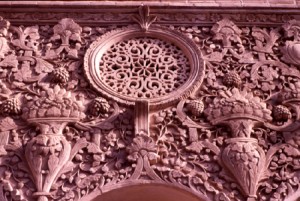When I did my single story extension I had the usual, mundane modern plasterwork done – smooth plaster on plaster boards to create a plain finish for painting. But my luxurious bedroom in my loft will have all sorts of joists and angles visible, and this is why decorative plasterwork became so popular – to hide all the ugly structural parts.
So, I am now talking to my builder about the idea of having something fancy done! As usual, I have conducted some thorough research into plastering, here are my findings!
Ceilings, Cornices and Corbels – Plasterwork Is Back In Fashion

Cornice plaster
Plastering is such a time-honoured decorative technique – even as far back as Roman times plaster was a key building and decorative method – so it is not surprising it’s back in fashion.
The desire to create something unique in a home is easily achievable with the various decorative techniques, and sympathetic renovations and a desire to use a property’s original features have seen a healthy demand for skilled plasterer services.
Plasterwork through the ages

Stucco from the House of Borujerdi-ha, 1850s, Kashan, Iran.
The Romans used stucco – a mixture of gypsum, marble dust and lime to decorate ceilings and this subsequently became widely used throughout Europe. Inspired partly by the Italian Renaissance and a desire to emulate a Baroque style, decorative plasterwork was used to often spectacular effect in some of Britain’s stately homes and large houses.
The Georgian era saw extensive use of plasterwork, led by the famous Scottish brothers Robert and John Adam of ‘Adam fireplace’ fame.
Decorative plaster served a practical purpose in that structural joints could be concealed by cornices, and this technique became highly popular in the mid-nineteenth century when a new type of fibrous plaster incorporating sheets of hessian to increase strength became available.
Because this fibrous plaster was much lighter than the solid type, it was possible to make complete lengths of cornices and other items such as panels and skirting in one pre-fabricated section.
When fibrous plaster was combined with moulds to create the ornate decorative details, it had the effect of ‘mass producing’ and standardising the manufacture of plasterwork thus making it more affordable. This heralded the extended use of plasterwork in even the more humble Victorian-era houses, and its use carried on well into the 1930’s.
In general terms, in the decades that followed more simplified interior decor prevailed in the form of plasterboard for ceilings and ‘just’ plastered walls in the interests of minimalism. This article in Period Living provides more info on the history of plasterwork.
Plasterwork today
Especially popular for older properties where old plasterwork is being uncovered and renovated, modern plasterwork techniques blending modern materials with traditional methods make the process affordable and effective. It’s a particularly attractive way of making a home unique – some cornicing and maybe a ceiling rose or two can put an individual stamp on a room.
A definition of some decorative plastering items:
Corbel – an ornate bracket providing structural support for an arch or cornice.
Cornice – a protrusion marking the border of the upper wall to the ceiling. Sometimes simple in design but can be very intricate.
Dado – the lower part of a wall between the skirting and the dado rail.
Pargeting – a type of exterior decorative plastering used on walls.
Ceiling rose – a decorative moulding of usually circular design mostly used as a surrounding of a light fitting such as a chandelier.
Finding an expert
The manufacture of decorative plastering is often handled off site by a specialist. The plasterwork or mouldings are made at their base before being transported to the building concerned and installed. There are a surpisingly large number of expert plasterers (master craftsmen?) still around – the art is certainly far from being dead. A reasonably local one to me is Regency Plaster, who are in Enfield. Their cornices are stunning – far nicer than the bog standard cornice that is put up in new homes.
Expertise is required if existing plasterwork is being uncovered and restored. For example, removing layers of old paint from existing plaster has to be done carefully so as not to damage the plasterwork, so seeking the services of a reputable plaster professional is advisable.
Plaster – the Evergreen Solution!
Even though it took a bit of a back seat during the mid-years of the twentieth century, plaster as a material providing a feature of a property has bounced back in recent times. The modern techniques make it possible to give rooms a unique look. No doubt there is a uPVC alternative, but sometimes we should add a little luxury into our homes!
